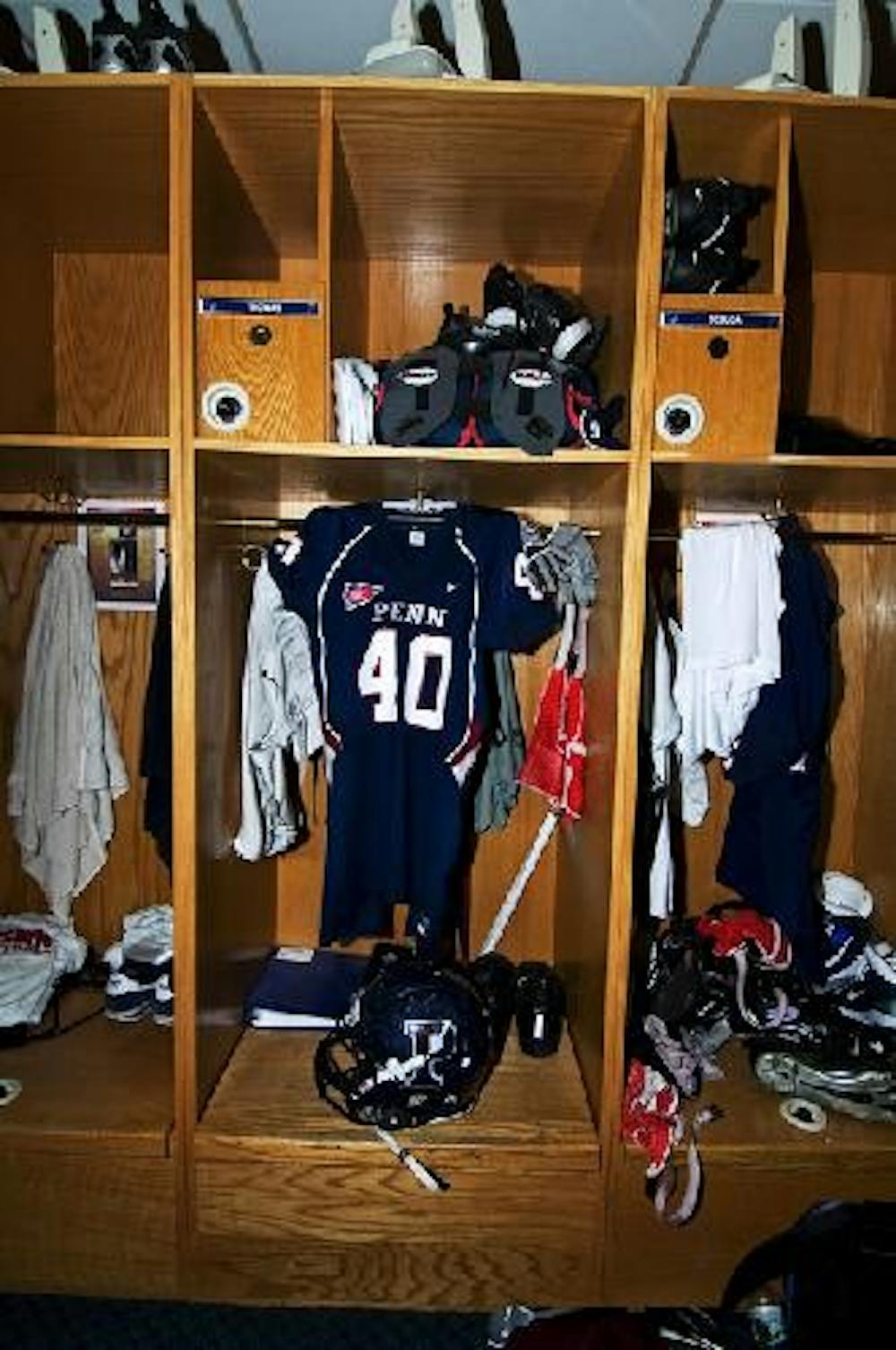
It shouldn’t have been so hard for Taylor Brown.
It was senior year, after all. Sure, it was training camp, but the Quakers would go on to win the 2012 Ivy League championship that season and Brown had earned the right to enjoy the entire ride.
Instead, Brown was disconnected from the outside world.
He couldn’t stand up. Colors changed. His awareness was low.
And so he spent football training camp of his senior year in 2012 in a dark apartment room. No TV. No laptop. No cell phone. Just enough experience to know he’d be suffering from anxiety and memory loss for months, even after this was over.
It shouldn’t have been so hard for Ursula Lopez-Palm.
It was her seventh consecutive year of taking French, after all. But nothing was sticking. There she was in French class, struggling like never before to translate piece by piece what her professor was saying.
Penn women’s soccer would go on to win the 2010 Ivy League championship that season, and as the eventual team leader in goals, Lopez-Palm had earned the right to enjoy the entire ride.
Instead, she knew she was headed for a dark room too.
It shouldn’t have been so easy for Kameron Jones.
He knew all the symptoms. Dizziness. Sensitivity to light. Forgetting playing half the game and throwing up at night.
So by the time he joined Penn football as a freshman defensive end in 2008, he knew how to hide all the effects of the multiple concussions he sustained before coming to Penn. He wishes now that he had been more forthcoming with his concussions then, but players want to play.
Today he estimates he suffered close to four concussions during his Penn football career, bringing his lifetime concussion total to six. Jones didn’t report any of them to Penn’s coaching staff.
He was too busy fighting in the trenches with his defensive linemate Owen Thomas. One day after Jones had a bad practice, he found himself alone in the locker room with Thomas.
“He came up to me and said, ‘Kamdog Jefferson, you know what they say...When there’s white water in the morning...’
“Yes?” Jones asked.
“That’s it!” Thomas responded.
It was a quote from Thomas’ favorite movie, “Almost Heroes,” starring the actor most reminiscent of Thomas according to his teammates: Chris Farley.
“While most would have given a half-hearted, ‘It will all work out,’ Owen knew I would get through it on my own and a laugh would be the best first step towards a better mood,” Jones said.
Like Jones, Thomas was never diagnosed with a concussion. But Saturday will mark the fourth anniversary of Thomas hanging himself in his off-campus apartment, a tragedy that resulted in a brain autopsy that summer that made Thomas the first case of chronic traumatic encephalopathy (CTE) in an active college football player.
Unlearning Habits
CTE is a degenerative brain disease most likely caused by repetitive brain trauma whose effects are chiefly neurobehavioral, including impaired memory, erratic decision-making, depression and the possibility of suicide.
In September 2010, Rev. Kathy Brearley of Allentown, Pa., told her not his son Owen’s story before the House Education and Labor Committee, her son’s Parkland High School helmet sitting before her on the hearing room table. The summer following Thomas’ death, the Ivy League limited the number of full-pad contact practices that can take place throughout the football year, also enacting new in-season practice limitations permitting no more than two full-contact days per week, a 60 percent reduction from the NCAA maximum.
But hitting will always be a part of football. For many players, it’s the whole point of playing the game. They’re used to “getting their bell rung” and ringing their opponents’ bells in return.
“By the time you’re at Penn, most players have been playing for 10 years,” 2008 Penn football graduate Naheem Harris said. “It’s extremely difficult to unlearn some of those habits.”
“I can’t wait to hit the guy tomorrow!” Thomas would exclaim to his mother after the first day of contact at Parkland High summer practice every season. “Owen, that’s your teammates,” Brearley would point out.
“I know, but I can’t wait to hit them!”
Out of 14 Penn football alumni interviewed for this story, seven said they sustained concussions while playing for Penn. Of those seven, five said they concealed what they suspected were concussions from the Penn coaching staff. Moreover, 12 out of 44 Penn alumni athletes from the last decade across five different varsity programs interviewed said they sustained at least one concussion at Penn, and the vast majority of them said they knew teammates who had been concussed. While these numbers are by no means wholly conclusive, they do beg the question: How do you fight players’ impulse to keep playing?
“Seeing the trainer is like going to the dentist,” 2005 Penn graduate and former football player Mike Recchiuti said. “You try to avoid going as long as possible until you are in so much pain you can’t handle it and are forced to go.”
Between the Baselines
Al Bagnoli can see Franklin Field from his spacious Weightman Hall office.
“It’s a great view,” he says wistfully the day before word leaks that he plans to retire as Penn football coach following the 2014 season.
And in his 22 seasons at Penn, he’s seen it all. In fact, seeing used to be believing when it came to concussion testing on the sidelines during games. If a kid looked and talked OK, back into game action he went.
“‘How many fingers do I have up?’ ‘Count backwards,’” Bagnoli says. “You don’t say that anymore.”
Since 2006, Bagnoli’s players have taken a computerized neurological baseline test just upstairs from his office.
When a player receives his first concussion, an automatic three-day window begins in which the coaching and training staff cannot do anything with him whatsoever. After the three-day window passes, players are available to go through baseline testing and remain shut down until they pass the test. The next day, players go out in a T-shirt and shorts to be put through physical drill work by trainers who determine whether the players still show concussion symptoms.
The day after that — now the fifth day after getting concussed — players determined to be symptom-free can return to practice in a limited capacity with shorts, shoulder pads, helmet and a red shirt indicating that they cannot be hit. Players whose return to practice goes well are then fully cleared. That’s six days from concussion to full clearance.
“It kind of takes the guesswork out of when you return to play,” Bagnoli says.
The Penn medical and coaching staffs record every diagnosed and reported concussion a player sustains throughout his career, dating back to high school.
But how do you fight players’ impulse to hide their concussions?
“You gotta educate the kids,” Bagnoli says.
By NCAA mandate, one of the very first things Penn coaches do during the preseason every August is show players a film outlining all the traits potentially associated with a concussion.
And indeed, most alumni commend the program for staying on top of concussion health.
“The coaches and training staff were very on top of sitting players out with concussions, no matter how good the player was,” Brown said.
Still, Brown laments the “handful” of concussions he hid from coaches.
“I know I definitely swept some under the rug in order to keep my playing time, which in hindsight was a terrible idea,” Brown said.
As a result of his mounting concussion history, though, Brown was barred from playing as a fifth-year senior in 2013.
That’s why Brown’s former teammate and 2012 graduate Jason Schmucker speaks up these days.
“I am still in touch with guys on the team and if I ever hear that one of them got a concussion, I implore them to take the extra time to fully heal,” Schmucker said.
Like Jones, Schmucker has suffered at least six concussions in his lifetime even as a safety, a position requiring fewer head-to-head collisions than most. He sustained three of them during game action at Penn, two of them in back-to-back games in 2011. As a result, he missed the final four games of his senior year.
“My family noticed a stark contrast between my normal happy-go-lucky, positive self and the person who came home over Thanksgiving and Christmas break that year,” Schmucker said.
It’s Your Brain
Concussions change people. Prior to his suicide, Owen Thomas had been an air guitar-wielding warrior. He lived for the adrenaline of the sport until it helped kill him.
Spreading the word about the potential for such terrible change is former Penn football team captain Nick Cisler. He volunteers with the Sports Legacy Institute, an organization founded in 2007 that is dedicated to furthering awareness of and research on sports-related head injuries. Cisler got involved after learning that the institute had partnered with Brearley to heighten concussion awareness following Thomas’ death.
Fortunately, there’s been positive change on the concussion front since Thomas’s CTE changed him forever for the worse.
“There is far more attention going into diagnosing, identifying causes and understanding the physiology and chemistry inside the brain [than five years ago],” Cisler said. “Only a few years ago it was a much different world and a much smaller pool of knowledge about the injury.”
Indeed, the slew of NFL alumni with CTE symptoms who have committed suicide in the past decade has pushed the issue of concussions firmly into the public consciousness. But it will only stay there if each new generation of athletes is filled in on the tragedies of the ones that came before.
Thomas’ brother Morgan and his wife are expecting a boy in August.
“It will be interesting to see what happens if they allow him to play football,” Brearley said. “He’s going to have to be told the whole story, and that’s just all there is to it.”
Telling the story is what matters now. As the fourth anniversary of Thomas’s death approaches and the temptation of playing through anything remains for current players, it’s up to coaches, trainers and alumni to keep awareness high.
“It’s my brain that we’re talking about,” Cisler said. “And I’d prefer for it to keep working well.”
The Daily Pennsylvanian is an independent, student-run newspaper. Please consider making a donation to support the coverage that shapes the University. Your generosity ensures a future of strong journalism at Penn.
DonatePlease note All comments are eligible for publication in The Daily Pennsylvanian.








